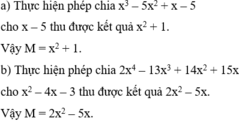

Hãy nhập câu hỏi của bạn vào đây, nếu là tài khoản VIP, bạn sẽ được ưu tiên trả lời.



Bài 1:
b: \(3x-6=x^2-16\)
\(\Leftrightarrow x^2-3x-10=0\)
\(\Leftrightarrow\left(x-5\right)\left(x+2\right)=0\)
\(\Leftrightarrow\left[{}\begin{matrix}x=5\\x=-2\end{matrix}\right.\)

bai1;
a)(3x-1)^2+(x+3).(2x-1)
=3x^2-6x+1+2x^2-1x+6x
=x^2-1x+1
b)(x-2).(x^2+2x+4)-x(x^2-2)
=x^3+2x^2+4x-2x^2-4x-8-x^3+2x
=2x-8
Bài 2:
a. \(x^3-27+3x\left(x-3\right)\)
\(=\left(x-3\right)\left(x^2+3x+9\right)+3x\left(x-3\right)\)
\(=\left(x-3\right)\left(x^2+3x+9+3x\right)\)
\(=\left(x-3\right)\left(x^2+6x+9\right)\)
\(=\left(x-3\right)\left(x+3\right)^2\)
b. \(5x^3-7x^2+10x-14\)
\(=5x\left(x^2+2\right)-7\left(x^2+2\right)\)
\(=\left(x^2+2\right)\left(5x-7\right)\)

a) Ta có: \(8x\left(2x-3\right)-4x\left(4x+3\right)=72\)
\(\Leftrightarrow16x^2-24x-16x^2-12x=72\)
\(\Leftrightarrow-36x=72\)
hay x=-2
b) Ta có: \(\left(x+2\right)\left(x+4\right)-x\left(x+2\right)=104\)
\(\Leftrightarrow x^2+6x+8-x^2-2x=104\)
\(\Leftrightarrow4x=96\)
hay x=24
c) Ta có: \(\left(x-1\right)\left(x+4\right)-x\left(x-1\right)=308\)
\(\Leftrightarrow x^2+3x-4-x^2+x=308\)
\(\Leftrightarrow4x=312\)
hay x=78
d) Ta có: \(15x\left(2x-3\right)-\left(5x+2\right)\left(6x-5\right)=-22\)
\(\Leftrightarrow30x^2-45x-30x^2+25x-12x+10=-22\)
\(\Leftrightarrow-32x=-32\)
hay x=1

\(a,3\left(2x-3\right)+2\left(2-x\right)=-3\\ \Leftrightarrow6x-9+4-2x=-3\\ \Leftrightarrow4x=2\\ \Leftrightarrow x=\dfrac{1}{2}\\ b,x\left(5-2x\right)+2x\left(x-1\right)=13\\ \Leftrightarrow5x-2x^2+2x^2-2x=13\\ \Leftrightarrow3x=13\\ \Leftrightarrow x=\dfrac{13}{3}\\ c,5x\left(x-1\right)-\left(x+2\right)\left(5x-7\right)=6\\ \Leftrightarrow5x^2-5x-5x^2-3x+14=6\\ \Leftrightarrow-8x=-8\\ \Leftrightarrow x=1\\ d,3x\left(2x+3\right)-\left(2x+5\right)\left(3x-2\right)=8\\ \Leftrightarrow6x^2+9x-6x^2-11x+10=8\\ \Leftrightarrow-2x=-2\\ \Leftrightarrow x=1\)
\(e,2\left(5x-8\right)-3\left(4x-5\right)=4\left(3x-4\right)+11\\ \Leftrightarrow10x-16-12x+15=12x-16+11\\ \Leftrightarrow-14x=-4\\ \Leftrightarrow x=\dfrac{2}{7}\\ f,2x\left(6x-2x^2\right)+3x^2\left(x-4\right)=8\\ \Leftrightarrow12x^2-4x^3+3x^3-12x^2=8\\ \Leftrightarrow-x^3-8=0\\ \Leftrightarrow-\left(x^3+8\right)=0\\ \Leftrightarrow-\left(x+2\right)\left(x^2-2x+4\right)=0\\ \Leftrightarrow\left[{}\begin{matrix}x=-2\\x\in\varnothing\left(x^2-2x+4=\left(x-1\right)^2+3>0\right)\end{matrix}\right.\)
Bài 4:
a: Ta có: \(3\left(2x-3\right)-2\left(x-2\right)=-3\)
\(\Leftrightarrow6x-9-2x+4=-3\)
\(\Leftrightarrow4x=2\)
hay \(x=\dfrac{1}{2}\)
b: Ta có: \(x\left(5-2x\right)+2x\left(x-1\right)=13\)
\(\Leftrightarrow5x-2x^2+2x^2-2x=13\)
\(\Leftrightarrow3x=13\)
hay \(x=\dfrac{13}{3}\)
c: Ta có: \(5x\left(x-1\right)-\left(x+2\right)\left(5x-7\right)=6\)
\(\Leftrightarrow5x^2-5x-5x^2+7x-10x+14=6\)
\(\Leftrightarrow-8x=-8\)
hay x=1

a) \(x^3+4x^2-29x+24=x^3-x^2+5x^2-5x-24x+24\)
\(=x^2\left(x-1\right)+5x\left(x-1\right)-24\left(x-1\right)\)
\(=\left(x-1\right)\left(x^2+5x-24\right)\)
\(=\left(x-1\right)\left(x^2+8x-3x-24\right)\)
\(=\left(x-1\right)\left[x\left(x+8\right)-3\left(x+8\right)\right]\)
\(=\left(x-1\right)\left(x+8\right)\left(x-3\right)\)
b) \(x^4+6x^3+7x^2-6x+1\)
\(=x^4+\left(6x^3-2x^2\right)+\left(9x^2-6x+1\right)\)
\(=x^4+2x^2\left(3x-1\right)+\left(3x-1\right)^2\)
\(=\left(x^2+3x-1\right)^2\)
c) \(\left(x^2-x+2\right)^2+\left(x-2\right)^2=x^4-2x^3+6x^2-8x+8\)
\(=\left(x^4-2x^3+2x^2\right)+\left(4x^2-8x+8\right)\)
\(=x^2\left(x^2-2x+2\right)+4\left(x^2-2x+2\right)\)
\(=\left(x^2-2x+2\right)\left(x^2+4\right)\)
d) Phức tạp mà dài quá :v
\(6x^5+15x^4+20x^3+15x^2+6x+1\)
\(=6x^5+3x^4+12x^4+6x^3+14x^3+7x^2+8x^2+4x+2x+1\)
\(=3x^4\left(2x+1\right)+6x^3\left(2x+1\right)+7x^2\left(2x+1\right)+4x\left(2x+1\right)+\left(2x+1\right)\)
\(=\left(2x+1\right)\left(3x^4+6x^3+7x^2+4x+1\right)\)
\(=\left(2x+1\right)\left[\left(3x^4+3x^3+x^2\right)+\left(3x^3+3x^2+x\right)+\left(3x^2+3x+1\right)\right]\)
\(=\left(2x+1\right)\left[x^2\left(3x^2+3x+1\right)+x\left(3x^2+3x+1\right)+\left(3x^2+3x+1\right)\right]\)
\(=\left(2x+1\right)\left(3x^2+3x+1\right)\left(x^2+x+1\right)\)
e)
- Câu này có thể áp dụng định lý: nếu tổng các hệ số biến bậc chẵn và tổng các hệ số biến bậc lẻ bằng nhau thì đa thức có nhân tử x + 1.
- Nhận thấy: 1 + 4 + 4 + 1 = 3 + 4 + 3
\(x^6+3x^5+4x^4+4x^3+4x^2+3x+1\)
\(=(x^6+x^5)+(2x^5+2x^4)+(2x^4+2x^3)+(2x^3+2x^2)+(2x^2+2x)+(x+1)\)
\(=x^5(x+1)+2x^4(x+1)+2x^3(x+1)+2x^2(x+1)+2x(x+1)+(x+1)\)
\(=(x+1)(x^5+2x^4+2x^3+2x^2+2x+1)\)
Tiếp tục phân tích bằng cách trên vì 1 + 2 + 2 = 2 + 2 +1
\(=\left(x+1\right)\left(x+1\right)\left(x^4+x^3+x^2+x+1\right)\)
\(=\left(x+1\right)^2\left(x^4+x^3+x^2+x+1\right)\)
a) Gọi CT ghi hóa trị của NH3 là \(N^xH^I_3\) (x: nguyên, dương)
Theo quy tắc hóa trị, ta có:
\(x.1=I.3\\ =>x=\dfrac{1.I}{3}=III\)
Vậy: Hóa trị của N có hóa trị III trong hợp chất NH3
b) Gọi CT kèm hóa trị của Zn(OH)2 là \(Zn^x\left(OH\right)^y_2\) (x,y: nguyên, dương).
Theo quy tắc hóa trị, ta có:
\(x.1=y.2\\ =>\dfrac{x}{y}=\dfrac{2}{1}=\dfrac{II}{I}\)
=> x=II
y=I
=> Hóa trị của Zn là II trong hợp chất trên

1) \(\dfrac{A\left(x-5\right)}{\left(x+1\right)\left(x-5\right)}=\dfrac{3x\left(x+3\right)}{\left(x+1\right)\left(x+3\right)}\)
\(\Rightarrow A=3x\)
2) \(\dfrac{\left(x+3\right)\left(x-2\right)}{A\left(x-3\right)}=\dfrac{\left(5x-1\right)\left(x-2\right)}{\left(5x-1\right)\left(x^2+3\right)}\)
\(\Leftrightarrow\dfrac{\left(x+3\right)}{A\left(x-3\right)}=\dfrac{1}{\left(x^2+3\right)}\)
\(\Rightarrow A=\dfrac{\left(x^2+3\right)\left(x+3\right)}{x-3}\)
3) \(\dfrac{\left(x-5\right)\left(x+5\right)}{\left(x+5\right)\left(2x-3\right)}=\dfrac{\left(x-5\right)A}{\left(2x-3\right)\left(x+2\right)}\)
\(\Leftrightarrow1=\dfrac{A}{\left(x+2\right)}\)
\(\Leftrightarrow A=x+2\)

Bài 12:
1) A = x2 - 6x + 11
= (x2 - 6x + 9) + 2
= (x - 3)2 + 2
Ta có: (x - 3)2 ≥ 0 ∀ x
Dấu ''='' xảy ra khi x - 3 = 0 ⇔ x = 3
Do đó: (x - 3)2 + 2 ≥ 2
Hay A ≥ 2
Dấu ''='' xảy ra khi x = 3
Vậy Min A = 2 tại x = 3
2) B = x2 - 20x + 101
= (x2 - 20x + 100) + 1
= (x - 10)2 + 1
Ta có: (x - 10)2 ≥ 0 ∀ x
Dấu ''='' xảy ra khi x - 10 = 0 ⇔ x = 10
Do đó: (x - 10)2 + 1 ≥ 1
Hay B ≥ 1
Dấu ''='' xảy ra khi x = 10
Vậy Min B = 1 tại x = 10

mk ghi kết quả thôi nhé, nếu từ kết quả mak k biết biến đổi thì ib cho mk
\(x^5-7x^4-x^3+43x^2-36=\left(x-6\right)\left(x-3\right)\left(x-1\right)\left(x+1\right)\left(x+2\right)\)
câu thứ 2 bạn ktra lại đề
\(x^4+2x^3-15x^2-18x+64=\left(x-2\right)\left(x^3+4x^2-7x-32\right)\)
\(x^3-x^2-4=\left(x-2\right)\left(x^2+x+2\right)\)
\(x^3-3x^2-4x+12=\left(x-3\right)\left(x-2\right)\left(x+2\right)\)
a) \(x^5-7x^4-x^3+43x^2-36\)
\(=x^3\left(x^2-1\right)-7x^2\left(x^2-1\right)+36\left(x^2-1\right)\)
\(=\left(x^2-1\right)\left(x^3-7x^2+36\right)=\left(x-1\right)\left(x+1\right)\left(x^3+2x^2-9x^2-18x+18x+36\right)\)
\(=\left(x-1\right)\left(x+1\right)\left(x+2\right)\left(x^9-9x+18\right)\)
\(=\left(x-1\right)\left(x+1\right)\left(x+2\right)\left(x-3\right)\left(x-6\right)\)
c) \(x^4+2x^3-15x^2-18x+64\)
\(=x^3\left(x-2\right)+4x^2\left(x-2\right)-7x\left(x-2\right)-32\left(x-2\right)\)
\(=\left(x-2\right)\left(x^3+4x^2-7x-32\right)\)